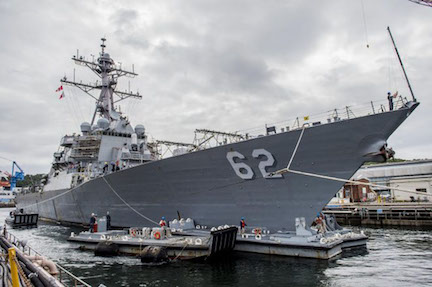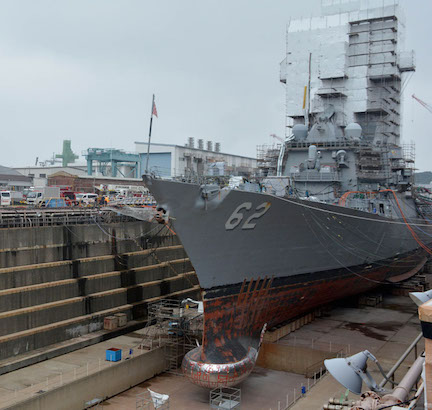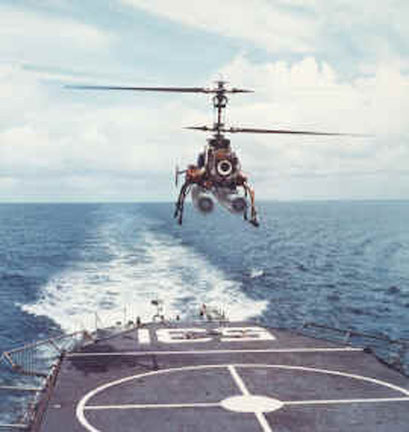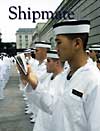
Shipmate Column
April 2017
CLASS OF
1963
Pres: CAPT W. Spencer Johnson IV, USN (Ret.)
Sec'y: Michael H. Shelley
164 Sweetwater Lane, Pisgah Forest, NC
28768
h: 828-862-4245 e: nstar@citcom.net
Web site: http://www.usna63.org.
For any classmate you can go to the Classmates Page and enter his name to read his current biography if available.
The early winter has been a slow time for Class of 1963 news, so this report will be unusually brief. The brevity indicates how much we rely on input from you. Please take a couple of minutes to send me an email about your recent activities and contacts with our classmates. We need your help.
I am sorry to report the death of Marion Mays, wife of our classmate Mickey Mays, on 26 December 2016. Mickey can be contacted at 8793 Robles Way, San Diego, CA 92119.
I saw these two U.S. Navy photos of FITZGERALD on the timely and informative Naval Institute News web site (www.news.usni.org) in late January. The first was taken on 15 June 2016 as the ship was arriving at Dry Dock 5 in Yokosuka, Japan; the second was made on 13 July. It's always good to see new images of the ship named for our classmate Bill Fitzgerald.
Here's some happy news from Gary Baldwin, telling us about the recent wedding of one of his sons.
The ceremony was held in a beautiful park in Phoenix, AZ, thankfully on a beautifully warm December day. The groom, Tim, is the youngest of our four sons. He and Bonnie, his bride, reside in the Phoenix area. Tim graduated as a nuclear engineer and has spent his career as a software entrepreneur (my words); Bonnie is involved in sales. I was blessed and honored to officiate the wedding ceremony and always very pleased when Joan and I can spend a few more days apart from the Minnesota winter.
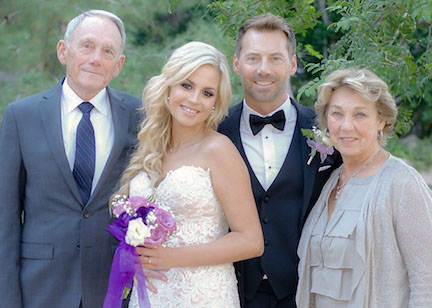
|
|
Warm weather wedding in Phoenix
|
After thirty years with Northwest Airlines I flew my last flight, London to Minneapolis, on December 28th, 1998.Since that time, Joan and I have spent our time enjoying our seven grandkids, some travel, some sailing, hiking, etc., and we have been for many years directors of a ministry called Healing Rooms where we minister to people's physical, emotional, and spiritual needs as a part of the International Association Of Healing Rooms. Living here in Minnesota I have little contact other than the web with classmates on the coasts. We travel often to Phoenix, so I occasionally have a chance to visit Lori and Ralph Stowell.
Now, how about a wedding photo from our generation? John Newsom has just submitted these then-and-now pictures for the Weddings section of our web site.
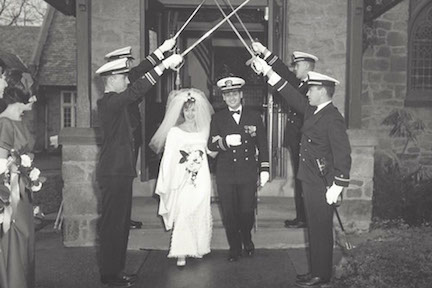
|
|
John and Carolyn Newsom on 4 February 1967
|
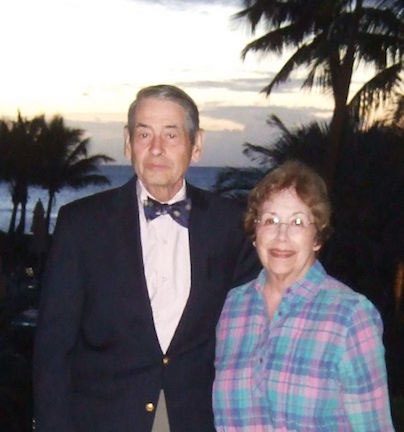
|
|
The Newsoms today
|
Many images of classmates and wives are already on the site. To see them, click HERE. [[www.usna63.org/classmates/Weddings. ]] Why not add yours? Just email them to Webmaster Steve Coester scoester@cfl.rr.com .
Mike Blackledge forwarded this entertaining account by Bill Pawlyk of the accidental impact of a torpedo on one of our aircraft carriers.
Sunny blue sky punctuated by scattered puffs of cloud, a moderate breeze kicking up scattered whitecaps on a sea state two ocean. A great day to be at sea. We were operating in the SOCAL Op Area (Southern California Operating Area) off San Diego with the USS Bennington (CVS-20). Bennington was a WWII era modified Essex class carrier, now designated to be the flagship for a "Hunter-Killer" anti-submarine warfare (ASW) task force.
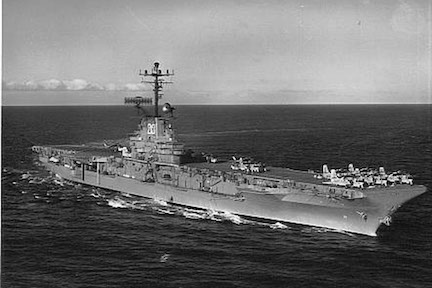
|
|
USS BENNINGTON (CVS-20)
|
My ship was also a WWII-era destroyer modified to excel at ASW. The second of three five-inch caliber gun mounts had been removed, replaced by two triple barrel ASW torpedo launchers, one on either side of the 01 deck just forward of the ship's bridge. Amidships, between the two stacks a rectangular box-like ASW rocket mount stood. Called an ASROC (Anti-Submarine Rocket) launcher, it could rotate and elevate to fire a rocket up to several miles away. Each rocket could carry either a homing torpedo with a conventional warhead or a nuclear depth charge. The Navy would not publicly state whether or not a ship actually carried the nuclear version of ASROC.
Atop the after end of the deckhouse, a hangar space and a small flight deck were constructed. The hangar was about the size of a one-and-a-half car garage, opening out to the flight deck area. This complex was for an early version of the modern drone aircraft, called the DASH (Drone Anti-Submarine Helicopter). DASH was a bare-boned construction of a jet engine fixed in an open pipe work frame with skids for landing gear.
It was capable of carrying two ASW torpedoes or a nuclear depth charge under its rib cage. In practice, the only authorized payloads were conventional warhead torpedoes. This was because the remote control technology and reliability of the DASH itself was suspect. Several DASH birds were lost in training exercises, as they mysteriously refused to respond to the flight controller's commands. One climbed vertically to around 30,000 feet on its own until it shook itself to pieces and fell into the ocean. Several crashed into land as they cruised off unresponsively. They did not have a self-destruct feature, an addition that might have come in handy on these unguided forays. Another of our task force's destroyers that also had DASH, had its helo zoom away in mid ocean with that ship and ours in hot pursuit trying to regain command until it ran out of fuel and fell into the sea.
Back to our bucolic day at sea. On this beautiful day, the Secretary of the Navy was embarked onboard the Bennington to observe anti-submarine warfare operations. We were to demonstrate the DASH in all its glory. I was the Officer of the Deck (OOD), conning the ship. My position was mainly on the port wing of the bridge, on the side towards the carrier. My destroyer took position on the right hand (starboard) side of the Bennington, a hundred or so feet away, just forward of the carrier's island to afford the SECNAV group a firsthand view of the helicopter as it took off from the flight deck at the rear of our ship. The DASH was then to rise to masthead height, fly forward of both ships and make a racetrack pattern around them, coming up from astern in the gap between the two ships. The DASH carried one dummy torpedo shape that weighed several hundred pounds.
The launch was uneventful, and the DASH smoothly rose, flew forward and turned left across the bows of both ships, then proceeded back past the carrier circling astern to come up between the two ships at an altitude of about one hundred and fifty feet.
As the drone approached the ships, coming up from the rear, a cacophony of excited voices crackled over several radio circuits in alarm. Just prior to the DASH launch, the Bennington had launched a flight of twin-engine antisubmarine hunter aircraft, known as STOOFS for their military aircraft designation, S2F. This flight of four aircraft had catapulted from the carrier, swung out to sea and then back across the ships' course to land at San Diego's North Island Naval Air Station. The flight leader, on his own, decided to give the SECNAV a good show by making a very low pass across the bow of the Bennington. Unfortunately, his maneuver proved to be ill timed. His planes were on a virtual collision course with the DASH. Controllers tried to alert him and his wingmates of the danger and to pull up or veer off. The DASH controller on board our ship got similar warnings. At this point, the DASH was just astern of the Bennington's island structure, flying about the height of its stack, about midway (fifty feet from either ship). The STOOFs flashed by at almost the same altitude. The DASH did a little jiggle in midair, and swerved into the mattress spring-looking radar antenna on the Bennington. Shrapnel flew about, the fuel tank on the DASH burst into brilliant orange-yellow ball of flames, which spewed over the entire forward part of the carrier's island structure. Chunks of debris fluttered down the side of the island into the sea between the two ships. The torpedo shape flew over the gun director on top of the forward part of the island and down into the carrier's bridge, where it burst through the overhead onto the Navigator's plotting table. The ship's Navigator had just leaned over the table to check a position, when he turned around and stepped back just as the torpedo burst through, into the very spot he had been seconds before.
As fate would have it, the next evolution planned was a crash and damage control exercise. The carrier's fire-fighting crew was on the flight deck, with hoses already charged when the accident occurred. Before all of the debris had finished fluttering to the sea, the damage control teams had the entire forward part of the island foam covered and the fire extinguished. This also meant the bridge personnel could not see a thing, with the bridge enveloped in thick foam. They also were deaf and blind electronically. The crash severed their radio and radar connections.
Immediately, I ordered right full rudder and increased speed to pull safely away from the crippled carrier. Within a few minutes, the situation stabilized. Fire hoses swept the carrier's bridge free of foam, to restore visibility. Fortunately, no one was injured in the crash and fire. The damages limited to the carrier's island structure, including its antenna arrays and some scorched paintwork down the side of the island - and of course the destroyed DASH. The bridge of the Bennington had the torpedo securely imbedded in it, the tail still outside with the nose resting on the Navigator's table.
All ships immediately returned to port in San Diego. A formal investigation ensued. The upshot was not good for the S2F flight commander, whose career abruptly ended. Although it turned out that technically flying the DASH in the area we were operating in was in violation of Navy policy (too close to land), no one else suffered since lots of brass from the Admiral, to the Commodore of our destroyer squadron and my Captain were involved in approving the flight. My ship's flight controller was exonerated since no one could be sure exactly what caused the DASH to veer into the carrier's antennal. Conjecture included electronic interference from the high-powered radars, which were just feet away from the DASH; the turbulence from the low pass of the four aircraft; or a jittery hand of our DASH controller due to the excitement and the noise of the low pass of the aircraft.
The next day I was tasked to go to the shipyard, where the Bennington was docked for repairs, to retrieve the torpedo shape from the bridge. I stood on the carrier's bridge and watched as a shipyard crane slowly pulled the torpedo up and out, leaving a gaping hole in the overhead. I marveled that no one had been killed or injured. Within a week, the Bennington was as good as new.
And so, that is how I was involved in the torpedoing of an American aircraft carrier. We did not paint a carrier silhouette on our bridge as a memento, however -- although it might have been fitting.
That's all for now, folks. I'm hoping to hear from you soon.

